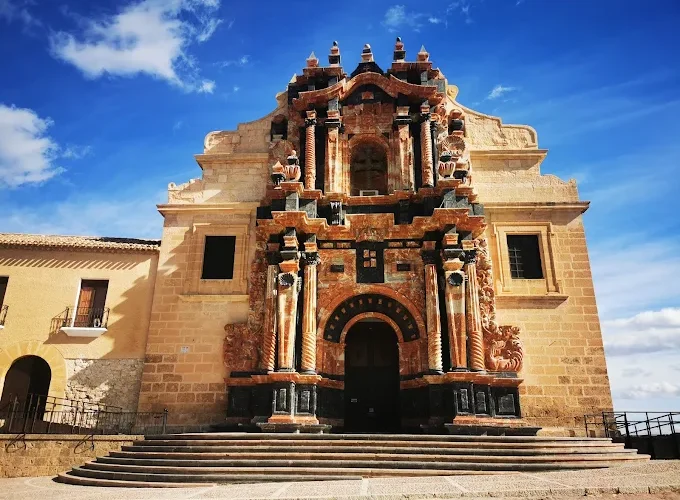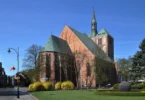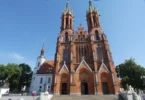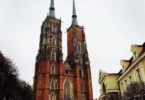Introduction
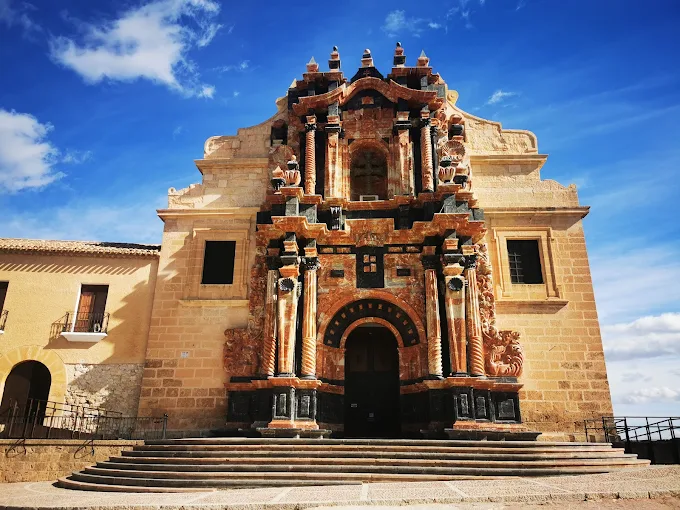
The Royal Basilica-Sanctuary of the True Cross (Spanish: Basílica de la Vera Cruz) is a prominent Roman Catholic church located in the historic town of Caravaca de la Cruz, in the Region of Murcia, southeastern Spain. Renowned for its religious significance and architectural heritage, the basilica serves as a major pilgrimage site, particularly revered for housing a relic of the True Cross, which according to tradition, is a fragment of the cross on which Jesus Christ was crucified. This sacred site has long been a center of devotion and spiritual tradition, drawing pilgrims from across the world, especially during Holy Jubilee Years, which Caravaca de la Cruz celebrates every seven years. In recognition of its religious importance and its role in promoting Catholic worship, the church was officially granted the title of minor basilica by the Dicastery for Divine Worship and the Discipline of the Sacraments on December 3, 2007. The basilica stands not only as a place of worship but also as a testament to the deep-rooted Christian heritage of the region, blending baroque architecture with centuries of spiritual legacy.
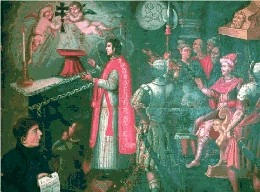
History and Construction
The sanctuary’s construction began in 1617, guided by the architectural vision of Friar Alberto de la Madre de Dios, a prominent court architect of the time. It was built inside the fortress walls of the castle of Caravaca, perched atop a commanding hill that offered both strategic and symbolic prominence. The design embraced the early Baroque style, which was the prevailing architectural trend in the early 17th century, characterized by ornate details and grandeur. This new sanctuary was constructed directly over an ancient medieval chapel that housed the Lignum Crucis a sacred relic believed to be a fragment of the True Cross on which Jesus Christ was crucified. The building process spanned several decades, reflecting both the complexity of the design and the importance of the site, and was ultimately completed in 1703, solidifying its presence as a major religious monument.
Role During and After the Spanish Civil War
After the conclusion of the Spanish Civil War, from April 1939, the sanctuary underwent a grim transformation under the Franco regime. Rather than serving purely as a place of worship, it was temporarily converted into a concentration camp for Republican prisoners captured during the conflict. This period marked a significant and somber chapter in the sanctuary’s history, contrasting starkly with its centuries-old role as a spiritual center and pilgrimage destination. The use of such a revered religious site for imprisonment highlights the turbulent political and social upheaval of that era.
Religious Importance and Pilgrimage Tradition
The sanctuary is renowned for housing and venerating the Cross of Caravaca, a religious relic of immense spiritual significance to Catholics. The tradition of pilgrimage to this sanctuary dates back to the 13th century, making it one of the oldest continuous pilgrimage sites in Spain. Pilgrims have journeyed here for centuries to seek spiritual blessings, participate in religious ceremonies, and honor the sacred Cross. The sanctuary’s importance was formally recognized by the Catholic Church when it was elevated to the rank of a minor basilica on February 2, 2008, by a decree issued by Pope Benedict XVI on December 3, 2007. This designation acknowledges the sanctuary’s historical, religious, and cultural significance, as well as its role in fostering Catholic devotion.
The Perpetual Jubilee Year Privilege
In January 1998, Pope Saint John Paul II granted the sanctuary an extraordinary privilege: the right to celebrate a perpetual Jubilee Year every seven years. This unique ecclesiastical honor allows the sanctuary to host special religious festivities and ceremonies that offer pilgrims and worshippers the opportunity to receive plenary indulgences, which are spiritual benefits granted by the Church that remit temporal punishment for sins. This perpetual Jubilee privilege is exceptionally rare, and only a handful of places worldwide share this distinction, including Jerusalem, Rome, Santiago de Compostela, and Santo Toribio de Liébana. This recognition firmly establishes the Sanctuary of the Cross of Caravaca as one of the most important and spiritually significant pilgrimage sites in the Christian world, drawing faithful from across the globe.
Architecture of Basilica of the Most Holy True Cross, Caravaca de la Cruz, Spain
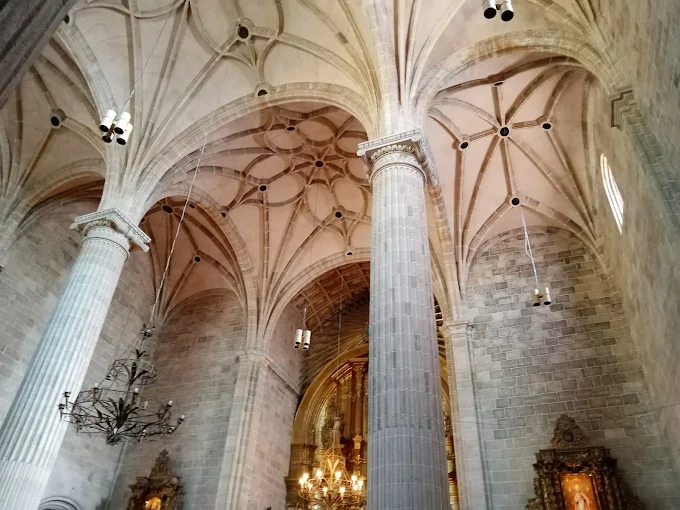
Architect : Alberto de la Madre de Dios
Architectural style : Baroque architecture.
Architecture of the Sanctuary
Design and Royal Patronage
The Sanctuary of the True Cross was meticulously designed by Friar Alberto de la Madre de Dios, a highly esteemed court architect, at the direct request of King Philip III. The king was deeply invested in promoting the veneration of the famous relic the fragment of the True Cross housed within the sanctuary and entrusted his favorite architect with this important mission. The church was conceived as a Baroque temple specifically to accommodate the growing number of pilgrims coming to honor the relic. It follows a Latin cross plan, a traditional layout symbolizing Christ’s crucifixion, which also facilitated processions and religious ceremonies.
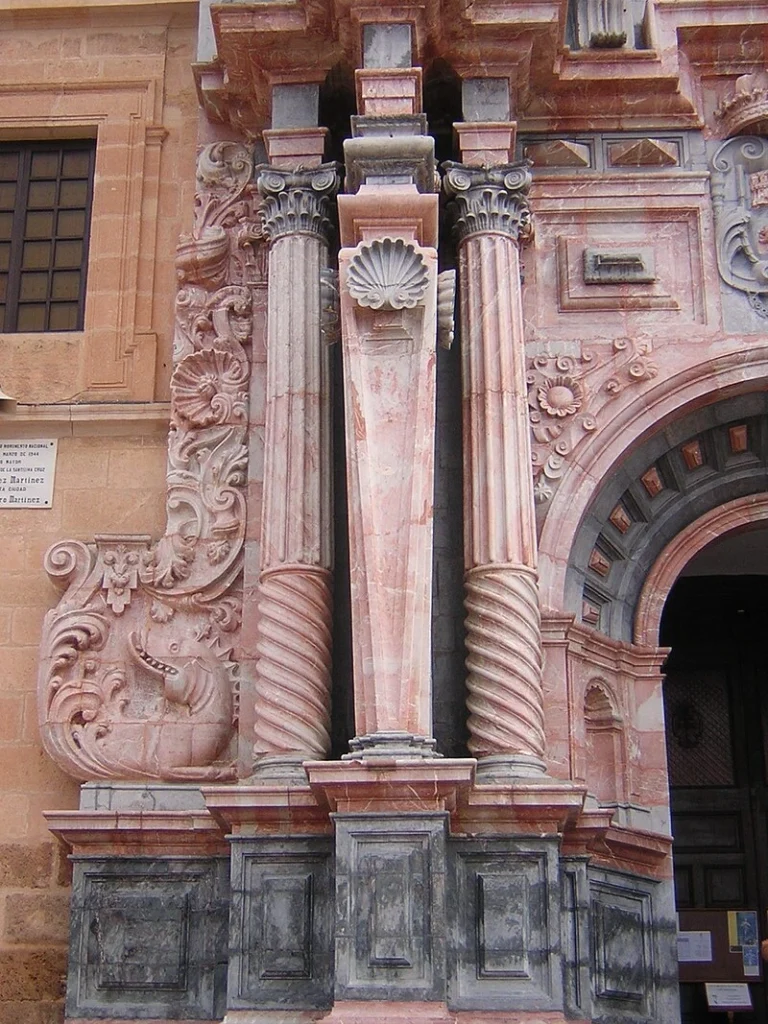
Façade and Exterior Ornamentation
Constructed in the 18th century, the sanctuary’s façade is regarded as one of the finest examples of Baroque architecture in the region. The façade is primarily built of local jasper marble, renowned for its rich reddish hues, layered on ashlar stonework. This marble choice not only reflects regional materials but also adds vibrant color and texture to the structure. The façade is richly adorned with floral motifs, voluminous cornices, and imposts that contribute to the Baroque’s characteristic theatricality designed to inspire awe and convey religious grandeur. Structural features such as stipes (stone pedestals) support column ensembles, creating a dynamic vertical rhythm. The royal coat of arms prominently sits above the main entrance, symbolizing the monarchy’s patronage. Adjacent to it is the shell emblem of the Order of Santiago, a military and religious order historically connected to the region, linking Caravaca’s religious heritage with its medieval military history.
Central to the façade’s symbolism is a niche housing a carved statue of the True Cross, the city’s patron saint, underscoring the sanctuary’s spiritual focus. The upper cornice gracefully curves at the top and is crowned by seven pinnacles, which draw the eye upward and emphasize the verticality typical of Baroque design. Below the cornice, on both sides, stand two elaborately sculpted beasts amid floral scrollwork. Locally called the Red Dragons because of the marble’s red coloration, these creatures are iconic symbols of Caravaca, believed to protect the sanctuary and add a layer of local folklore to the religious narrative. Due to its architectural significance and artistic beauty, the sanctuary was officially declared a National Historic-Artistic Monument in 1944, ensuring its preservation and recognition as a cultural treasure.
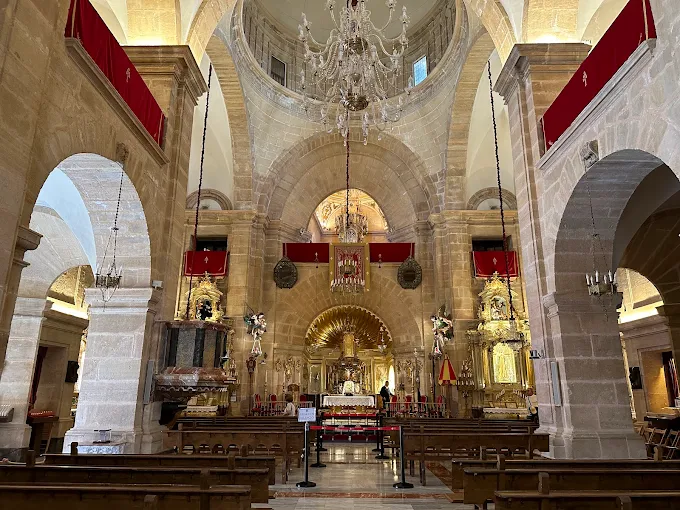
Interior of the Basilica
Structural Organization and Style
Inside, the basilica is arranged with three naves a central nave flanked by two side aisles following the architectural conventions of many European churches. The interior style is described as post-Herrerian, a movement influenced by the austere and solid designs of architect Juan de Herrera, known for his work on El Escorial. This style is characterized by the robustness and severity of its walls, which creates a sense of weightiness and solemnity. This interior austerity contrasts markedly with the ornate and theatrical exterior, providing a contemplative space focused on spirituality and devotion.
Key Architectural Elements
On the Gospel side (left when facing the altar), visitors can access the sacristy, a room where sacred vessels and vestments are kept. Opposite this, on the Epistle side (right), lies the Chapel of the Vera Cruz de Caravaca, the sanctuary’s spiritual heart where the revered relic is venerated. The upper portion of the interior is arranged as an ambulatory, a walkway allowing visitors and pilgrims to circulate around the church’s interior, providing different perspectives and views of the altar and other sacred spaces. This design element enhances the liturgical function and visitor experience.
Choir and Historic Organ
The choir area houses an organ constructed in 1776 by the notable organ builder José Folch. The instrument is historically important for its craftsmanship and musical quality. Unfortunately, the organ was severely damaged during the Spanish Civil War, reflecting the sanctuary’s troubled 20th-century history. Following extensive restoration efforts completed in 2003, the organ was returned to its former glory and is now used regularly during important religious ceremonies and services, enriching the sanctuary’s worship experience with its historic sound.
Museum of the Sanctuary of the True Cross
Location and Collections
The museum is situated within the grounds of the Royal Alcázar-Basilica of the Most Holy and True Cross, integrating seamlessly with the religious complex. It houses a comprehensive collection of sacred art and artifacts, including exquisite ornaments, goldsmithing, and a broad selection of religious paintings that chronicle the sanctuary’s long history and devotional significance.
Artistic Highlights
A standout piece in the museum’s collection is the painting “The Healing of Tobias” by Rafael Tejeo, a prominent 19th-century artist born in Caravaca. Tejeo is celebrated as one of Spain’s finest neoclassical painters and is especially renowned for his portrait work. His inclusion in the museum underscores the sanctuary’s connection to local artistic heritage and enriches the cultural experience of visitors.
Detailed Architectural Features and Surroundings
Façade Ornamentation and Symbolism
Close examination of the façade reveals meticulous stone carving that includes not only floral motifs but symbolic elements deeply tied to Caravaca’s identity and religious tradition. The use of the Order of Santiago’s shell and the Red Dragons blends local legend with Christian iconography, creating a facade that is both artistically impressive and culturally meaningful.
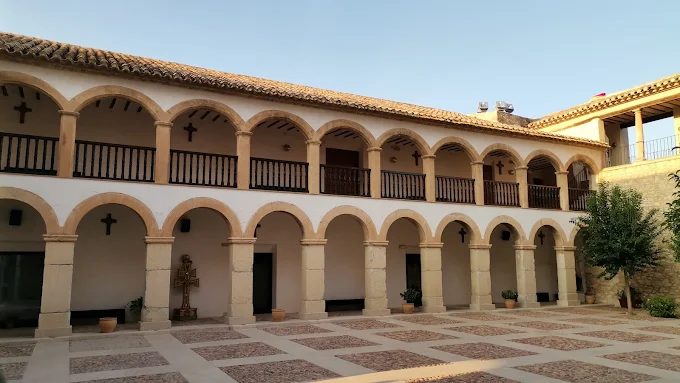
The Chaplain’s House and Sanctuary Complex
Attached to the basilica is the Chaplain’s House, an essential structure that supports the sanctuary’s day-to-day religious functions. Together, the basilica, museum, and chaplaincy form a comprehensive religious and cultural complex that continues to be a focal point for pilgrims, historians, and art enthusiasts alike.
Feast Day
Feast Day : 03 May
The feast day of the Basilica of the Most Holy True Cross in Caravaca de la Cruz, Spain, is celebrated on May 3rd each year. This date commemorates the Feast of the True Cross, which honors the relic of the True Cross housed in the basilica and is a major religious event in Caravaca.
Church Mass Timing
Monday to Saturday : 08:30 AM, 12:00 PM
Sunday : 12:00 PM, 06:00 PM
Church Opening Time:
Monday : 8:00 AM – 2:00 PM, 4:00 PM – 7:00 PM
Sunday : 10:00 AM – 2:00 PM, 5:00 PM – 7:00 PM
Contact Info
Address : Basilica of the Most Holy True Cross
Cta. Castillo, 9, 30400 Caravaca de la Cruz, Murcia, Spain.
Phone : +34 968 70 77 43
Accommodations
Connectivities
Airway
Basilica of the Most Holy True Cross, Caravaca de la Cruz, Spain, to Aeródromo de Caravaca de la Cruz, distance 17 min (10.8 km) via RM-730.
Railway
Basilica of the Most Holy True Cross, Caravaca de la Cruz, Spain, to Old Train Station Lugar Charco, distance 6 min (1.4 km) via C. Cta. Castillo.

